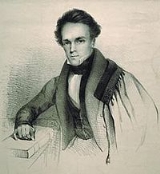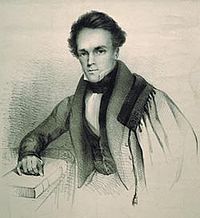
George Bennett
Encyclopedia

England
England is a country that is part of the United Kingdom. It shares land borders with Scotland to the north and Wales to the west; the Irish Sea is to the north west, the Celtic Sea to the south west, with the North Sea to the east and the English Channel to the south separating it from continental...
-born Australian physician
Physician
A physician is a health care provider who practices the profession of medicine, which is concerned with promoting, maintaining or restoring human health through the study, diagnosis, and treatment of disease, injury and other physical and mental impairments...
and naturalist
Natural history
Natural history is the scientific research of plants or animals, leaning more towards observational rather than experimental methods of study, and encompasses more research published in magazines than in academic journals. Grouped among the natural sciences, natural history is the systematic study...
.
Early life
Bennett was born at PlymouthPlymouth
Plymouth is a city and unitary authority area on the coast of Devon, England, about south-west of London. It is built between the mouths of the rivers Plym to the east and Tamar to the west, where they join Plymouth Sound...
, England. On leaving school at 15 years of age he visited Ceylon and on his return studied for the medical profession, initially at Plymouth, later at the Middlesex Hospital and the Hunterian School of Medicine. He obtained the degree of M.R.C.S. on 7 March 1828, and later became F.R.C.S.
Career
After qualifying as a physician Bennett obtained employment as a ship's surgeon, and visited SydneySydney
Sydney is the most populous city in Australia and the state capital of New South Wales. Sydney is located on Australia's south-east coast of the Tasman Sea. As of June 2010, the greater metropolitan area had an approximate population of 4.6 million people...
in 1829. ln 1832 his friend Richard Owen
Richard Owen
Sir Richard Owen, FRS KCB was an English biologist, comparative anatomist and palaeontologist.Owen is probably best remembered today for coining the word Dinosauria and for his outspoken opposition to Charles Darwin's theory of evolution by natural selection...
was engaged in examining the structure and relations of the mammary glands of the Ornithorhyncus
Platypus
The platypus is a semi-aquatic mammal endemic to eastern Australia, including Tasmania. Together with the four species of echidna, it is one of the five extant species of monotremes, the only mammals that lay eggs instead of giving birth to live young...
, and Bennett became so interested that on leaving England shortly afterwards for Australia he determined while in that country to find a solution of the question.
In May 1832 Bennett left Plymouth on a voyage which terminated almost exactly two years later. An account of this appeared in 1834 in two volumes under the title Wanderings in New South Wales, Batavia, Pedir Coast, Singapore and China. In 1835 Bennett published in the Transactions of the Zoological Society of London, vol. I, pp. 229-58, "Notes on the Natural History and Habits of the Ornithorhyncus paradoxus, Blum", one of the earliest papers of importance written on the platypus
Platypus
The platypus is a semi-aquatic mammal endemic to eastern Australia, including Tasmania. Together with the four species of echidna, it is one of the five extant species of monotremes, the only mammals that lay eggs instead of giving birth to live young...
.
In 1833, he lent support to the founding of what became the Royal Entomological Society of London
Royal Entomological Society of London
The Royal Entomological Society of London is devoted to insect study. It has a major national and international role in disseminating information about insects and improving communication between entomologists....
. Bennett was awarded the honorary gold medal of the Royal College of Surgeons in recognition of his contributions to zoological science. Bennett went to Australia again in 1836 and established a successful practice as a physician at Sydney. However he kept up his general interest in science, and acted as honorary secretary of the Australian Museum
Australian Museum
The Australian Museum is the oldest museum in Australia, with an international reputation in the fields of natural history and anthropology. It features collections of vertebrate and invertebrate zoology, as well as mineralogy, palaeontology, and anthropology...
which had just been established. He compiled A Catalogue of the Specimens of Natural History and Miscellaneous Curiosities deposited in the Australian Museum which was published in 1837. In 1860 he brought out his Gatherings of a Naturalist in Australasia. He kept up a correspondence with his early friend Sir Richard Owen, to whom he had sent the first specimens of the Nautilus to arrive in England, and with Darwin
Charles Darwin
Charles Robert Darwin FRS was an English naturalist. He established that all species of life have descended over time from common ancestry, and proposed the scientific theory that this branching pattern of evolution resulted from a process that he called natural selection.He published his theory...
and other scientists of the time. He was much interested in the Sydney botanic gardens and the Acclimatization Society, and was a vice-president of the Zoological Society, and a member of the board of the Australian Museum.
Bennett also contributed papers to the The Lancet
The Lancet
The Lancet is a weekly peer-reviewed general medical journal. It is one of the world's best known, oldest, and most respected general medical journals...
, the Medical Gazette, the Journal of Botany, Loudon's Magazine of Natural History, and other journals. The variety of his interests may be suggested by the fact that he published in 1871 papers on "A Trip to Queensland in Search of Fossils" and on "The Introduction, Cultivation and Economic Uses of the Orange and Others of the Citron Tribe".
Late life and legacy
Bennett was 84 years of age when he contributed the chapter on "Mammals" to the Handbook of Sydney, prepared for the Sydney meeting of the Australasian Association for the Advancement of Science held in 1888. The Royal Society of New South WalesRoyal Society of New South Wales
The Royal Society of New South Wales is a learned society based in Sydney, Australia. It was established as the Philosophical Society of Australasia on 27 June 1821...
awarded Bennett the Clarke memorial medal
Clarke Medal
The Clarke Medal is awarded by the Royal Society of New South Wales for distinguished work in the Natural sciences.Named in honour of the Reverend William Branwhite Clarke, one of the founders of the Society...
in 1890 for his valuable contributions to the natural history of Australia. Bennett died in Sydney on 29 September 1893.
Bennett is commemorated in science by the scientific names of the Dwarf Cassowary
Dwarf Cassowary
The Dwarf Cassowary, Casuarius bennetti, also known as the Bennett's Cassowary, Little Cassowary, Mountain Cassowary, or Mooruk, is the smallest of the three species of cassowaries.-Taxonomy:...
(Casuarius bennettii), the Little Crow (bird) (Corvus bennettii) and Bennett's Tree-kangaroo
Bennett's Tree-kangaroo
Bennett's Tree-kangaroo, or Dendrolagus bennettianus, is a large tree-kangaroo. Males can weigh from 11.5 kg up to almost 14 kg , while the females range between about 8 to 10.6 kg...
(Dendrolagus bennettianus).
Works authored or translated
- Bennett, George (1834). Wanderings in New South Wales, Batavia, Pedir Coast, Singapore and China: being the journal of a naturalist in those countries, during 1832, 1833 and 1834 (Vol. 1) London: Richard Bentley, University of Hong Kong Libraries, Digital Initiatives, China Through Western Eyes
- Bennett, George (1834). Wanderings in New South Wales, Batavia, Pedir Coast, Singapore and China: being the journal of a naturalist in those countries, during 1832, 1833 and 1834 (Vol. 2) London: Richard Bentley, University of Hong Kong Libraries, Digital Initiatives, China Through Western Eyes

